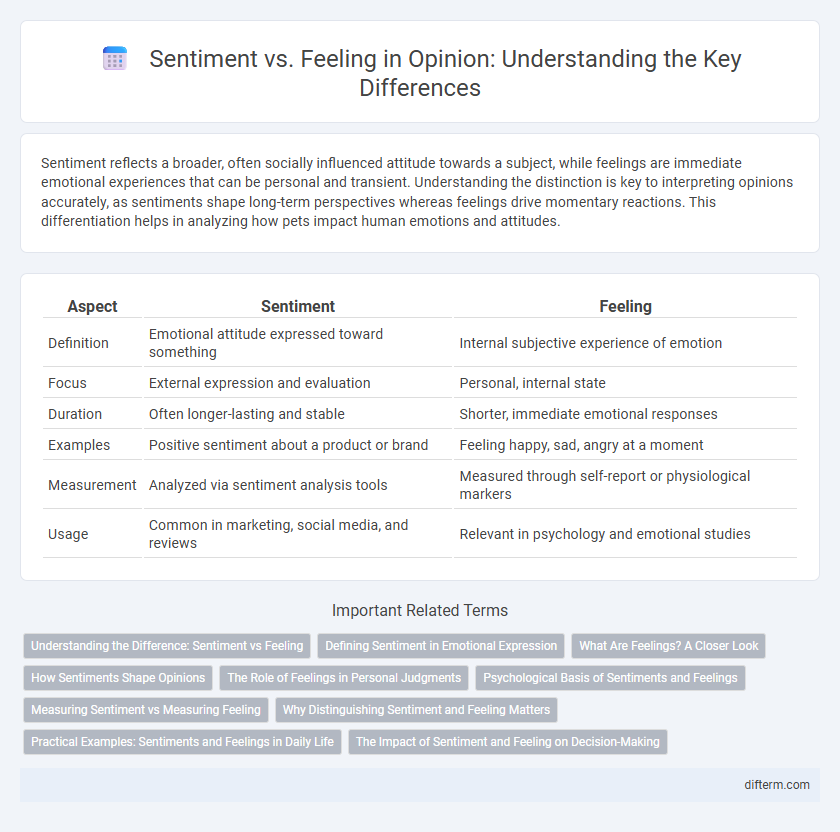Sentiment reflects a broader, often socially influenced attitude towards a subject, while feelings are immediate emotional experiences that can be personal and transient. Understanding the distinction is key to interpreting opinions accurately, as sentiments shape long-term perspectives whereas feelings drive momentary reactions. This differentiation helps in analyzing how pets impact human emotions and attitudes.
Table of Comparison
| Aspect | Sentiment | Feeling |
|---|---|---|
| Definition | Emotional attitude expressed toward something | Internal subjective experience of emotion |
| Focus | External expression and evaluation | Personal, internal state |
| Duration | Often longer-lasting and stable | Shorter, immediate emotional responses |
| Examples | Positive sentiment about a product or brand | Feeling happy, sad, angry at a moment |
| Measurement | Analyzed via sentiment analysis tools | Measured through self-report or physiological markers |
| Usage | Common in marketing, social media, and reviews | Relevant in psychology and emotional studies |
Understanding the Difference: Sentiment vs Feeling
Sentiment refers to an expressed attitude or opinion toward a subject often shaped by experience and context, while feeling is the internal emotional state that may be more spontaneous and less structured. Understanding the difference between sentiment and feeling is crucial for accurately interpreting human responses and communication, especially in fields like psychology and data analysis. Recognizing sentiment involves analyzing the external expression and its impact, whereas feelings are intrinsically personal and subjective experiences.
Defining Sentiment in Emotional Expression
Sentiment in emotional expression refers to the underlying attitude or opinion conveyed through language and behavior, often capturing broader social or cultural evaluations. Unlike feelings, which are immediate and subjective emotional experiences, sentiments represent more stable and generalized emotional stances shaped by cognitive appraisal. This distinction highlights sentiment as a crucial component in understanding how individuals communicate complex emotional perspectives beyond momentary feelings.
What Are Feelings? A Closer Look
Feelings are direct, conscious experiences of emotional states, representing the subjective awareness of physiological and psychological changes. They serve as internal signals that inform decision-making by encoding personal interpretations of stimuli. While sentiments are broader, more stable emotional attitudes, feelings are transient and immediate experiences that shape moment-to-moment human behavior.
How Sentiments Shape Opinions
Sentiments play a crucial role in shaping opinions by providing an emotional foundation that influences judgment and decision-making processes. Unlike fleeting feelings, sentiments are deeper, more enduring emotional states that guide individuals' perceptions and biases toward specific topics or entities. Understanding the interplay between sentiments and opinions helps in predicting behavior and tailoring communication strategies effectively.
The Role of Feelings in Personal Judgments
Feelings serve as intrinsic signals guiding personal judgments by providing immediate, visceral responses that shape perceptions and decisions. Unlike abstract sentiments, feelings originate from bodily and emotional states, influencing how individuals evaluate experiences and form opinions. This seamless integration of feelings ensures that judgments are not purely rational but are enriched by subjective emotional depth, enhancing authenticity and personal relevance.
Psychological Basis of Sentiments and Feelings
Sentiments arise from cognitive evaluations and learned associations shaping emotional responses over time, rooted in psychological theories of appraisal and social conditioning. Feelings are immediate, subjective experiences of emotions influenced by physiological states and neural processes in brain regions like the amygdala and insula. Understanding the psychological basis highlights that sentiments integrate complex cognitive patterns, whereas feelings represent direct, momentary emotional awareness.
Measuring Sentiment vs Measuring Feeling
Measuring sentiment typically involves analyzing quantifiable data such as social media posts, reviews, or survey responses to determine public opinion polarity, often using natural language processing algorithms to classify positive, negative, or neutral attitudes. Measuring feeling, however, delves deeper into emotional nuances by capturing subjective experiences through psychometric assessments, biometric data, or in-depth qualitative interviews, aiming to uncover the intensity and complexity of human emotions. Sentiment analysis excels in broad-scale opinion tracking, while feeling measurement prioritizes emotional depth and individual psychological states.
Why Distinguishing Sentiment and Feeling Matters
Distinguishing sentiment from feeling clarifies emotional analysis, as sentiment often reflects broader, socially-influenced attitudes while feelings are immediate, personal experiences. This differentiation enhances accuracy in fields like marketing, psychology, and AI sentiment analysis by targeting nuanced emotional responses versus general sentiment trends. Understanding these distinctions allows for more effective communication strategies and emotional intelligence development.
Practical Examples: Sentiments and Feelings in Daily Life
Sentiments represent enduring emotional attitudes shaped by experience, such as a long-standing distrust of public speaking, while feelings are immediate responses like anxiety before a presentation. Daily life examples include feeling joy upon receiving a compliment and holding a sentiment of gratitude toward a close friend. Recognizing the distinction between fleeting feelings and persistent sentiments enhances emotional awareness and interpersonal communication.
The Impact of Sentiment and Feeling on Decision-Making
Sentiment influences decision-making by shaping the overall emotional tone toward an option, often driving choices through subconscious emotional associations. Feelings provide immediate, conscious emotional responses that can heighten risk assessment and prompt swift action or hesitation. Understanding how sentiment and feelings diverge enables more nuanced evaluations of consumer behavior and strategic decision processes.
sentiment vs feeling Infographic

 difterm.com
difterm.com